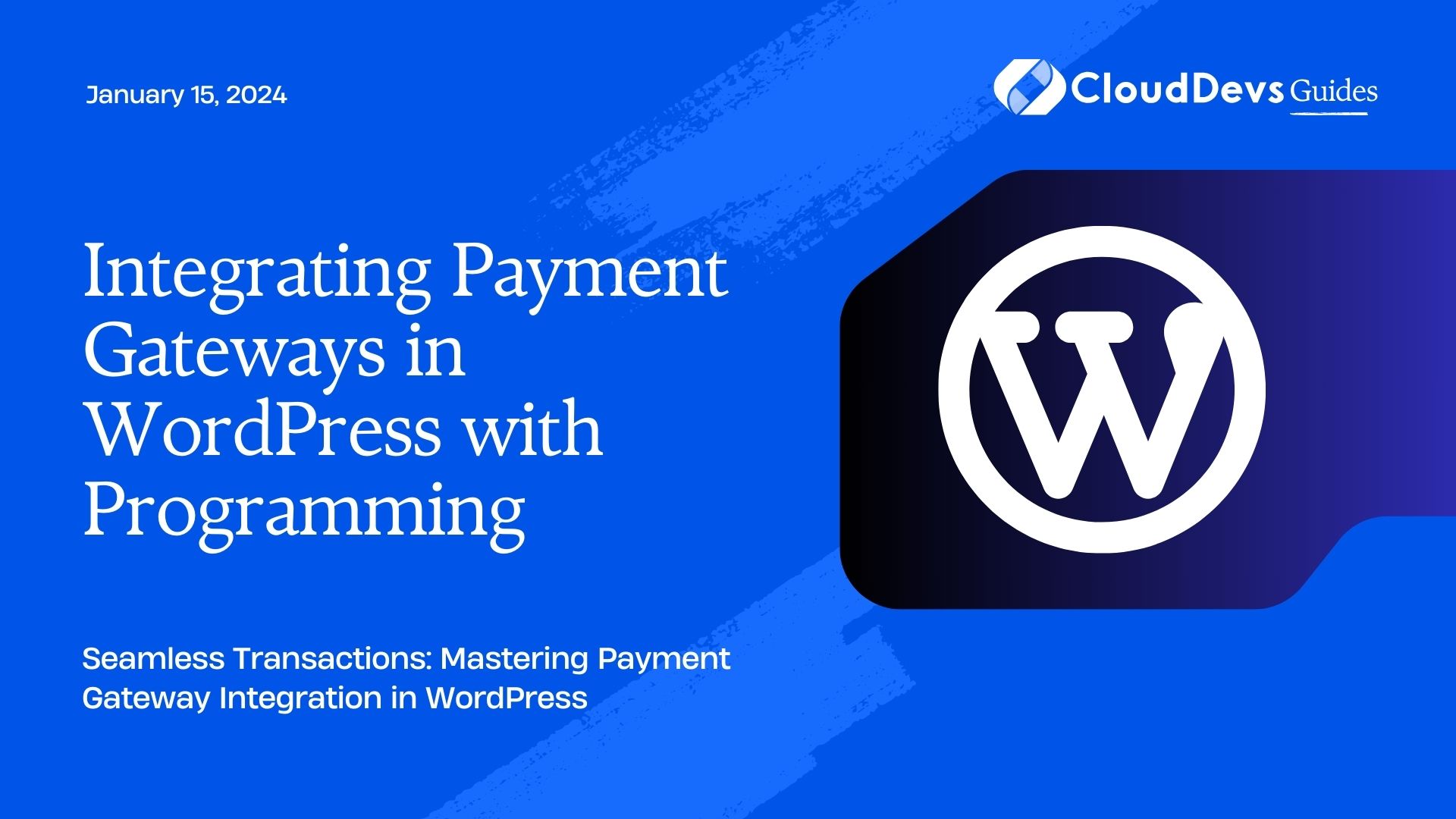Integrating Payment Gateways in WordPress with Programming
In today’s digital age, eCommerce has become a vital part of the business landscape. If you’re running a WordPress website and want to enable online payments, integrating payment gateways is the key to success. This comprehensive guide will walk you through the process of integrating payment gateways into your WordPress site using programming, providing you with the tools and knowledge needed to facilitate smooth transactions and enhance your user experience.
Table of Contents
1. Why Integrate Payment Gateways in WordPress?
Before diving into the technical details, it’s important to understand why integrating payment gateways in WordPress is essential for your online business.
- Enhances User Experience: Offering multiple payment options improves user experience, making it more convenient for your customers to complete transactions.
- Boosts Credibility: Payment gateways add a layer of security and trust to your website, which can boost your brand’s credibility.
- Increases Conversions: A seamless payment process reduces cart abandonment rates and increases conversion rates, leading to higher sales.
Now that we understand the importance, let’s get into the technical aspects of integrating payment gateways into your WordPress site.
2. Choosing the Right Payment Gateway
The first step in integrating payment gateways is selecting the right one for your business. WordPress supports a wide range of payment gateways, and your choice should align with your target audience, location, and the nature of your products or services.
Popular payment gateways for WordPress include:
- PayPal: Widely recognized and accepted globally, PayPal is a go-to choice for many online businesses.
- Stripe: Known for its developer-friendly APIs and robust security, Stripe is ideal for businesses of all sizes.
- WooCommerce Payment Gateway: If you’re using WooCommerce, its native payment gateway is a seamless option.
- Authorize.Net: A reliable choice for businesses in the United States.
- Square: Great for in-person and online payments, especially for small businesses.
Once you’ve chosen the payment gateway that best suits your needs, it’s time to start integrating it into your WordPress site.
3. Setting Up Your Development Environment
Before you begin coding, you need to set up your development environment. Ensure you have the following prerequisites:
- WordPress Installed: Make sure your WordPress website is up and running.
- A Code Editor: Use a code editor like Visual Studio Code or Sublime Text for writing and editing your code.
- Payment Gateway Account: Sign up for an account with the chosen payment gateway provider to access their API and obtain API keys.
- SSL Certificate: Ensure your website has an SSL certificate to encrypt sensitive data during transactions.
4. Programming the Integration
4.1. Obtain API Credentials
To integrate a payment gateway, you’ll need API credentials provided by your chosen gateway provider. These credentials typically include:
- API Key
- API Secret
- Merchant ID
- Consult your payment gateway’s documentation to find out how to obtain these credentials.
4.2. Install and Configure a Payment Gateway Plugin
Many payment gateways offer official plugins for WordPress. Install the relevant plugin for your chosen gateway. For instance, if you’re using Stripe, search for the “Stripe for WooCommerce” plugin and install it.
After installation, navigate to the plugin’s settings page within your WordPress dashboard. Here, you’ll enter the API credentials you obtained earlier.
4.3. Create a Payment Page
To process payments, you’ll need a dedicated payment page or checkout page on your website. You can create this page using a page builder or by manually creating a page template in WordPress.
For example, if you’re using WooCommerce, you can create a custom WooCommerce template for your payment page. In your template, include the necessary code to display the payment form.
php
<?php
/*
Template Name: Custom Payment Page
*/
get_header();
?>
<div id="primary" class="content-area">
<main id="main" class="site-main">
<div class="container">
<div class="row">
<div class="col-md-8">
<article id="post-<?php the_ID(); ?>" <?php post_class(); ?>>
<div class="entry-content">
<!-- Add your payment form code here -->
</div>
</article>
</div>
</div>
</div>
</main>
</div>
<?php
get_footer();
?>
Customize the payment form according to your gateway’s requirements, such as specifying the payment amount and item details.
4.4. Handle Payment Processing
Once the user submits the payment form, you need to handle the payment processing in your code. Depending on your payment gateway, this may involve sending a request to the gateway’s API and handling the response.
Here’s an example using the Stripe PHP library to charge a credit card:
php
// Include Stripe PHP library
require_once('path-to-stripe-php/stripe-php/init.php');
// Set your API key
\Stripe\Stripe::setApiKey('your-stripe-api-key');
// Create a customer and charge the card
try {
$customer = \Stripe\Customer::create([
'email' => 'customer@example.com',
'source' => $_POST['stripeToken'],
]);
$charge = \Stripe\Charge::create([
'customer' => $customer->id,
'amount' => 1000, // Amount in cents
'currency' => 'usd',
]);
// Payment successful
echo 'Payment successful!';
} catch (\Stripe\Exception\CardException $e) {
// Payment failed
echo 'Payment failed: ' . $e->getError()->message;
}
Remember to replace ‘your-stripe-api-key’ with your actual Stripe API key.
4.5. Handle Payment Callbacks
After a successful payment, the payment gateway typically sends a callback to your website to confirm the transaction. You need to set up a callback URL and code to handle these callbacks securely.
php // Callback URL https://yourwebsite.com/payment-callback // Callback Handling Code // Verify the callback request and update the order status in your database
Consult your payment gateway’s documentation for details on handling callbacks.
5. Testing Your Integration
Before deploying your payment gateway integration to your live website, it’s crucial to thoroughly test it in a staging environment. Use test card details provided by your payment gateway to simulate transactions and ensure everything works as expected.
5.1. Sandbox/Test Mode
Most payment gateways offer a sandbox or test mode that allows you to test transactions without processing real payments. Activate this mode in your payment gateway plugin settings.
5.2. Test Cards
Payment gateways often provide test card details for various scenarios, such as successful payments, declined payments, and card validation errors. Use these test cards to cover different scenarios and validate your integration thoroughly.
5.3. Error Handling
Pay close attention to error handling during testing. Make sure your integration gracefully handles errors and provides clear feedback to users when something goes wrong.
6. Security Considerations
Security is paramount when handling online payments. Here are some security considerations to keep in mind:
- SSL Certificate: Ensure your website has a valid SSL certificate to encrypt data transmitted during transactions.
- PCI Compliance: If you’re storing payment information, ensure your website is Payment Card Industry Data Security Standard (PCI DSS) compliant.
- Regular Updates: Keep your WordPress installation, plugins, and themes up to date to patch security vulnerabilities.
- Security Plugins: Consider using security plugins to add an extra layer of protection to your website.
- Data Encryption: Use encryption to protect sensitive data both in transit and at rest.
Conclusion
Integrating payment gateways into your WordPress website with programming can be a powerful way to enhance your online business. By following the steps outlined in this guide, you can provide a seamless and secure payment experience for your customers, ultimately boosting your sales and credibility.
Remember that the specifics of integration may vary depending on your chosen payment gateway and eCommerce platform. Always consult the official documentation of your payment gateway and seek professional assistance if needed. With the right payment gateway and a solid integration, your WordPress website can become a hub for successful online transactions.
Now that you have the knowledge and code samples to get started, take the leap and start accepting payments on your WordPress site, opening up new opportunities for growth and success in the world of eCommerce. Happy coding!
Table of Contents








